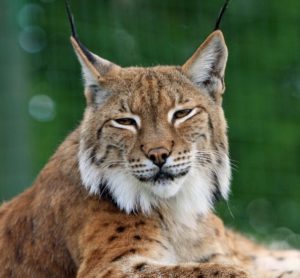Bobcats, though seldom seen, are the most common wildcat in North America. The Bobcat, Lynx rufus, is named for its short, bobbed tail. They are medium-sized cats and are slightly smaller, but similar in appearance to their cousin, the lynx. Rumors of Bobcats being seen on Headwaters Trail, in Pondbrook Conservation area west of Aurora, and several other areas in Northeast Ohio are growing. Many landowners have been surprised to see a Bobcat show up unexpectedly on their trail cam. Populations of this reclusive and elusive cat are making a nice rebound, especially in Southern Ohio in old, reclaimed strip mines. Bobcats were once found throughout most of North America and southern Canada. By the mid-1900s, bobcat populations in many Midwestern and eastern states of the United States were decimated due to the increased value of their fur. A single quality pelt could be worth $600. This caused the number of Bobcats killed annually to rise from 10,000 to over 90,000. Unfortunately, Bobcats were extirpated (gone) from Ohio by 1850. Although the Bobcat has been hunted to the brink of extinction, it is a survivor. The Ohio Division of Wildlife received reports of 226 unverified bobcat sightings in 2014; however, 197 reports were verified by ODNR officials. (road-killed, incidentally trapped, photographed.)
 Bobcats are extremely adaptable and are found in any manner of habitats from deserts to swamps. However, they prefer the forest, especially forested bluffs and rock out-croppings. Bobcats are solitary and territorial animals; females never share territory with each other. Male territories, however, tend to overlap. Territories are established with scent markings and territory sizes are extremely varied, generally 25-30 square miles for males and about five square miles for females.
Bobcats are extremely adaptable and are found in any manner of habitats from deserts to swamps. However, they prefer the forest, especially forested bluffs and rock out-croppings. Bobcats are solitary and territorial animals; females never share territory with each other. Male territories, however, tend to overlap. Territories are established with scent markings and territory sizes are extremely varied, generally 25-30 square miles for males and about five square miles for females.
Adult male bobcats weigh 16 to 30 pounds and average 3 feet in length. Females are considerably smaller and may weigh less than a large house cat. Bobcats can be various shades of buff and brown, with dark brown or black stripes and spots on some parts of the body. The tip of the tail and the backs of the ears are black. They have short ear tufts, and ruffs of hair on the side of the head, giving the appearance of sideburns.
Bobcats are carnivores and opportunistic hunters. They will prey upon a wide variety of animals. Mice, voles, rabbits, ground hogs, beaver, and fawns. From time to time they will eat insects, reptiles, birds, and carrion. When times are really hard, domestic animals are taken including house cats, chickens, small pigs, and lambs. Bobcats hunt primarily by sight and sound and are excellent hunters. Bobcats, stalk their prey with stealth and patience, which means they spend much of their time sitting or crouching, watching, and listening. Once their meal is within range of a quick dash, they pounce and dinner is served. Adult Bobcats have few predators other than cougars and humans. Young bobcats are killed by eagles, great horned owls, coyotes, foxes, bears, and adult male bobcats.
Males and females only come together at the breeding season, which is December to April. After a gestation of approximately 50-70 days, a litter of 2- 3 kittens are born between April and July. Female Bobcats may have several dens, one main den and several auxiliary dens, in their territory. Dens may be found in caves, rock crevices, or hollow logs or trees. The den is carefully lined with dry leaves, moss, or grass formed into a shallow depression. Baby bobcats weigh 9.75-12 ounces at birth and will open their eyes at around 6 days. They are weaned between 3-4 months of age and are run out of their mother’s territory between eight and eleven months of age. Young Bobcats reach sexual maturity around 12 months for females, and 24 months for males.
From one of the first animals on Ohio’s endangered species list to now being seen in 31 counties, who knows you might be lucky enough to see one as you go out to enjoy Nearby Nature.









